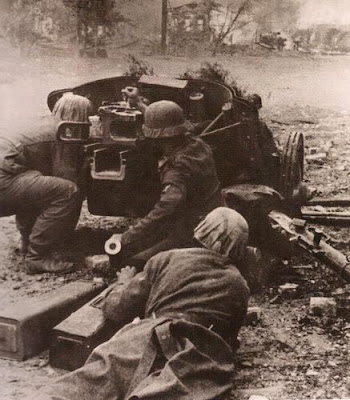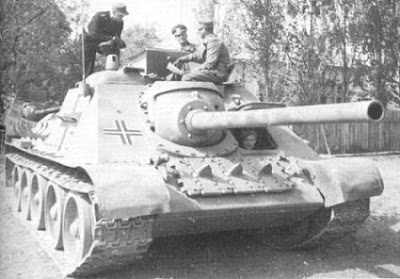5 cm Panzerabwehrkanone 38
PaK 38
El PaK 38 de 50 mm era un diseño convencional de cañón anticarro y fue el primer cañón anticarro alemán en estar a la altura del blindaje de los carros aliados. El proyecto fue desarrollado desde 1938 por Rheinmetall-Borsing pero no se introdujo en los campos de batalla hasta 1940, después de las experiencias de combate en Polonia y Francia cuando las tropas alemanas reclamaban un cañón con capacidad anticarro efectiva a larga distancia pues el ligero PaK 36 de 37 mm era inefectivo a largas distancias o contra vehículos bien protegidos como los carros franceses. Sin embargo el PaK 38 se desarrolló bajo la sombra del PaK 36 y casi llega demasiado tarde, cuando se hacía necesario un cañón anticarro de mayor calibre.
Ya en 1928 se había determinado que las prestaciones del Pak 36 de 37 mm eran escasas y a pesar de ello se decidió que era adecuado, al menos por el momento. El Tratado de Versalles aún estaba vigente y el desarrollo de un cañón de mayor calibre hubiera despertado sospechas con lo que el proyecto del PaK 36 continuó adelante. Se modificó la longitud del PaK 38 para lograr una velocidad inicial de 870 metros por segundo consiguiendo perforaciones de 72 mm a 500 metros de distancia. Algunos cañones fueron construidos para ser instalados en búnkeres cambiándose el afuste e incorporando un sistema para disparar eléctricamente.
Fue adecuado durante un tiempo hasta que hubo de enfrentarse al T-34 y la serie KV en 1941. Con suerte podían anotarse un triunfo al alcanzarles las orugas e inmovilizarlo, trabarle la torreta con un impacto entre esta y el casco o un disparo afortunado en la parte posterior del vehículo. En un principio debía apoyar a los cañones de 37 mm en aquellos puntos débiles de la defensa, sin embargo la aparición de los carros rusos provocó un cambio en la táctica con los PaK 38, ahora se abandonaba los campos de tiro anchos para ocultarlo y acechar al enemigo. Se pretendía una producción que pudiera sustituir al PaK 36 y además cubrir las pérdidas sufridas en el campo de batalla, pero en mayo de 1942 solo había disponibles 2.500 cañones PaK 38. A pesar de estas intenciones la producción fue decayendo al entrar en producción cañones anticarro de 75 mm y en 1944 solo quedaban 839 piezas de 5 cm, solo en agosto de 1943 se perdieron un total de 313 piezas PaK 38. Salvando sus deficiencias el PaK 38 se mantuvo firme en su defensa hasta al final de la guerra anotándose victorias sobre los menos blindados carros de los aliados occidentales.
Tenía un alcance efectivo máximo de 1.800 metros pero contra blindajes más espesos el alcance se reducía a 500 metros o incluso menos. Se intentó mejorar el rendimiento del cañón con la introducción de nuevos proyectiles con núcleo de tungsteno pero estos proyectiles eran escasos debido a la carencia de materias primas que padecía Alemania convirtiéndose en un lujo contar con alguno de ellos. Una munición de carga hueca fue diseñada especialmente para el PaK 38 (Steilgranate 42) con el objetivo de alargar la vida operativa del cañón pero su alcance se redujo a 150 metros.
El cañón era de diseño convencional con un freno de boca, escudo blindado para proteger a la dotación y recámara semiautomática. Su cureña era metálica al igual que las ruedas y disponía de una suspensión de barras de torsión. La Luftwaffe también usó el arma como cañón antiaéreo (Flak 214)
Fuente y más información:
ORMEÑO, J. "Cañones anticarro de fabricación alemana 1933-1945" SERGA nº 60
English version
The PaK 38 was a 50 mm antitank gun of conventional design and was the first German antitank gun to keep up the shield of cars allies. The project was developed in 1938 by Rheinmetall-Borsinger but was not introduced into the battlefield until 1940, after combat experiences in Poland and France when German troops demanded an effective anti-tank gun capable of long distance because the light PaK 36 of 37 mm was ineffective over long distances or against well-protected vehicles such as cars French. However, the PaK 38 was developed under the shadow of the PaK 36 and almost too late, when it required a larger caliber antitank gun.
In 1928 it was determined that the performance of the Pak 36 37 mm were rare and although it was decided that it was appropriate, at least for now. The Treaty of Versailles was still in force and the development of a larger caliber gun would have aroused suspicion with which the project went ahead PaK 36. Changed the length of the PaK 38 to achieve an initial velocity of 870 meters per second getting holes 72 mm to 500 feet away. Some guns were built to be installed in the front stock switching bunkers and adding a system to fire electrically.
SS PaK 38 with 22 kills and counting...
Was adequate for a while until he had to face the T-34 and KV series in 1941. Hopefully they could score a win to overtake the tracks and immobilize it, lock the turret with an impact between it and the helmet or a lucky shot in the back of the vehicle. In the beginning was to support the 37 mm cannons on those weaknesses of the defense, however the appearance of Russian tanks caused a change in tactics with the PaK 38, now abandoned shooting ranges wide to hide and stalk the enemy. They wanted a production that could replace the PaK 36 and also cover losses on the battlefield, but in May 1942 were available only PaK 38 guns 2500. Despite these intentions, production was declining to go into production of 75 mm anti-tank guns and in 1944 there were only 839 pieces of 5 cm, only in August 1943 lost a total of 313 pieces PaK 38. Saving its shortcomings the PaK 38 was firm in his defense to the end of the war chalking up wins over the less armored cars of the Western allies.
It had a maximum effective range of 1,800 meters but thicker armor against the scope was reduced to 500 meters or less. We attempted to improve the performance of the barrel with the introduction of new projectiles with tungsten core, but these shells were scarce due to lack of raw materials which Germany suffered from becoming a luxury to have one of them. A shaped charge ammunition was specially designed for the PaK 38 (Steilgranate 42) with the objective of extending the operating life of the barrel but its scope was reduced to 150 meters.
The gun was of conventional design with a muzzle brake, armored shield to protect the crew and bedroom semi. His carriage was metal like the wheels and had a torsion bar suspension. The Luftwaffe also used the weapon as an anti-aircraft gun (Flak 214)
Source and more information::
ORMEÑO, J. "Cañones anticarro de fabricación alemana 1933-1945" SERGA nº 60































